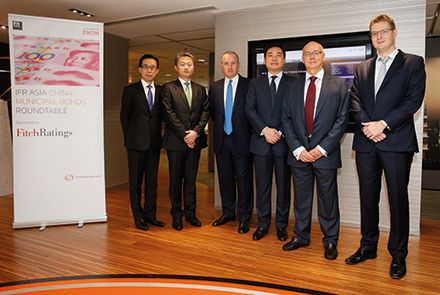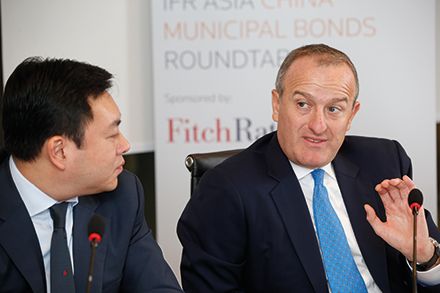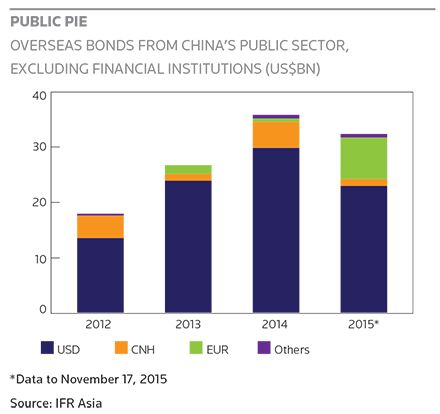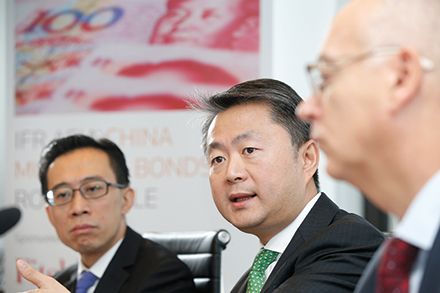IFR ASIA: Let me come to you first, Fernando. Just set the scene for us here. What’s happening in the Chinese municipal sector, and why would it make sense for local government enterprises to consider the capital markets?
FERNANDO MAYORGA, FITCH RATINGS: To really put it in context, I think we need to go back to 1994. I know it’s 20 years ago, but that’s when local and regional governments began to establish government-related financing vehicles, LGFVs, to do the work that usually the local governments do in other countries.
Local governments were not allowed to borrow, so the LGFVs started to issue debt. And then the government’s stimuli in 2008-09 were also partly undertaken by the regional provincial governments through the LGFVs, so debt increased quite a bit. Then there was a government audit in 2013 and 2014, which suddenly started showing that there was a lot of debt out there, and that the central government wanted to control it. Since then, we’ve seen the debt swap programme in 2015 transferring some of the debt from the LGFVs to local government.
The role of the local governments has become important for economic development in China. There is a lot of encouragement for them to do something on the investment side, while the government is making sure that it knows exactly what’s out there, and who is responsible for what.
That’s what’s happening now. We see a lot of the debts being transferred to local governments, because of the role that they play in the funding of these vehicles.
IFR ASIA: Is it another stimulus that’s going on at the moment?
FERNANDO MAYORGA, FITCH RATINGS: Not so much a stimulus. The economy is slowing down a bit, so the government needs to do something to get the economy going, but I don’t think they’re using these vehicles as necessary as the stimuli.
I think they’re also concerned about the debt of local governments, which is already quite significant if you consider the debt to GDP ratio is about 38%, including debt where there is a strong moral obligation. That’s quite large compared to other countries, in terms of GDP.
Some of the governments have started borrowing offshore, and that’s because the interest rate at the time in foreign currency was a lot lower than domestic borrowing. The gap is now narrowing, so I think some of these vehicles are rethinking their strategy, whether they borrow offshore, or domestically.
IFR ASIA: David, we’ve seen a couple of examples of companies out of China who’ve looked to the offshore market. Why does it make sense, and how do you see that developing?
DAVID YIM, STANDARD CHARTERED: When Beijing Infrastructure looked at the offshore market, the first LGFV to do so, they saw another funding channel. The Beijing underground is important to the government, and they need a lot of funding every year to fund the construction of other underground lines, whether it’s onshore or offshore.
At that time, the onshore market was not as liquid. And so that’s why they were looking to see whether the offshore market can supplement a little bit of the funding that they need.
They have done around US$3bn equivalent overseas. That’s maybe less than 5% of their total debt portfolio. So whatever the debt that companies get from the offshore market, it’s only a small piece.
Because of the rating that they got, and the strategic importance to Beijing, the funding cost for them was attractive, and they managed to find ways to remit the funds onshore. So it made sense for them. Since then, they’ve also tapped the Hong Kong dollar, RMB and euro, so you can say that they have access to all the investors and all the markets that they really want to tap.
That was the first one. And because it was successful, I think that started off all the other LGFVs. We recently also did one for Qingdao, the first perpetual for a LGFV offshore. That was for a different reason: the company, as with all the LGFVs, is typically quite leveraged. It was a senior perp, and that helped to lower the issuer’s leverage, while the company also found the funding cost acceptable. Most LGFVs are very important to the local governments and the investors are OK with the credits despite the leverage.
IFR ASIA: Barry, are you looking at a lot more of these in the pipeline?
BARRY FUNG, BNP PARIBAS: After these successful landmark transactions, a lot of local government financing vehicles, as well as infrastructure companies, would like to explore this new area.
It depends on a lot of factors: the market environment, their budget, their funding needs. I think a lot of them would like to explore it, but at the moment they are comparing the competitive advantage of different markets and trying to see whether it is more beneficial right now.
These companies would like to explore new funding channels, as well as go out to the international markets, but some have very competitive local onshore financing. I think they will continue to use that. The exact percentage really depends on the market.
IFR ASIA: How much of China’s local government funding could come overseas?
DAVID YIM, STANDARD CHARTERED: Some recent factors have changed that equation slightly. I won’t say that it has stopped, but definitely a lot of companies have different considerations around tapping offshore markets.
First of all, the US dollar-RMB exchange rate when it all started, maybe two years ago, was only moving one way. So for a lot of these companies with revenues in RMB, they didn’t really have to be concerned about FX risks when they issued in any foreign currency and brought it back onshore.
That has changed this year. Companies are now considering what happens if the RMB depreciates further, or substantially. Then they will be taking on unnecessary FX risks that they don’t want.
The other factor is that liquidity in the onshore market is much greater this year. That makes our jobs slightly harder, because the cost advantage is just not there anymore, on top of this FX issue. So some companies have taken a wait-and-see approach or have slowed down the process a little bit. That slows the number of issues that we expect to see this year.
BEN YUEN, BOCHK ASSET MANAGEMENT: This is a long-term trend. LGFVs have total debts of roughly around Rmb1.8trn maturing over the next five years, from 2015 to 2019. That’s on average around Rmb640bn maturing each year.
So, potentially, the new issues as well as this refinancing should be even higher than that. Of course, not all of that will go to offshore investors, a lot of it will stay onshore. But that number can be a good reference point globally.
IFR ASIA: The most recent audit of total local government liabilities put the total at Rmb24trn.
RICHARD DAWSON, KPMG: Just to add to that, often the LGFVs seeking advice tend to be from the less wealthy provinces, or provinces that have more funding challenges at the moment. I think that just reinforces the point. They don’t have the capability to look at different liquidity pools, perhaps because they don’t have the creditworthiness, or they don’t have the diversification opportunities.
I think that’s a trend we’ve seen in the last six months. We’ve seen some of the more Western provinces, or vehicles, assessing the market, which I think is testament to their not getting as much funding from central government, or it’s not as readily available, and they’re having to look for diversification more from a liquidity point of view than a pricing point of view.
IFR ASIA: It’s interesting how some are sophisticated enough to think about perpetuals. But there have been some provinces like Jiangsu that have had a tough time selling bonds onshore. This has to be a question for you Fernando: does the individual credit matter?
FERNANDO MAYORGA, FITCH RATINGS: Well it should matter, obviously. People have to price it somehow. We haven’t seen any example yet that a weaker province has a weaker capacity to repay its debt. I think the implicit government support is still there.
The central government is unlikely to want to see any province in repayment difficulties, and it will do whatever it needs to make sure that funds are made available, either from commercial or state-owned banks, or some other means. But still, I think there should be a price difference. We see that everywhere else where local governments issue debt. It needs to be priced according to the credit fundamentals.
There may not be a wide difference in China, in terms of ratings, at least among the top tier of provinces. When you get to lower tiers of government, then you’ll probably see a wider diversification of credit quality.
IFR ASIA: It does seem from the onshore debt swap programme that investors do care a little bit. On the offshore side, Ben, how much support would you factor in, when you look at something like this?
BEN YUEN, BOCHK ASSET MANAGEMENT: I think from the offshore investor’s vantage point, one of the most difficult things is the information differential between different provinces. We still can get the revenues and expenditures of that particular province. But we can’t get the detailed information, like individual balance sheets, audited statements, breakdown of capital and current expenditure and so on. So, that makes it quite difficult to price and to analyse each credit.
But in the medium to long term, let’s say the RMB gets into the SDR basket, I think that will have a very decent impact on demand for RMB-denominated bonds, because global demand for RMB will increase very substantially.
For investors looking to invest in the bond market, they can now choose between different types of risk, from government, municipal bonds, corporate bonds, etc. That is an advantage. I think long-term demand exists here. But in the short term we need to get more detailed information.
FERNANDO MAYORGA, FITCH RATINGS: That is a major problem. Transparency at the local government level in China is weak. It’s improving and, for some of the bigger provinces, you do have some financial information on their websites, but to get information from some of the weaker ones is not easy, and they aren’t very forthcoming in providing it, which is another problem.
In the 2013 audit, some of the figures for provincial debts were given individually. In the 2014 audit there was an aggregate figure. So what we have done is look at the June 2013 figures and factor an increase of about 40% on a province-by-province level. Obviously, we get up-to-date information for the provinces that we rate internally, because that’s part of our criteria. But for those we don’t rate, you have to make sometimes quite brave assumptions.
RICHARD DAWSON, KPMG: One of the central government’s challenges, as well, is to create information on a provincial level. This is one of the reasons why the law was changed and Directive 43 brought in. They too wanted more transparency, but it’s very new.
If I can talk like an accountant for a second, they didn’t have much concept about balance sheet or accrual accounting. China has signed off on it now, but it’s going to take until 2020. So, over time, that information will have to be reported on an accrual basis.
FERNANDO MAYORGA, FITCH RATINGS: It’s always difficult to come up with balance sheets, to put a value on assets, for local governments. Unless you have clear indications, you end up with very different figures from one local government to the other.
RICHARD DAWSON, KPMG: It’s also quite hard to find an accountant who can do it, it’s a specialised skill. There are very few and they are far between, that’s one of the challenges. China hasn’t had a culture of reporting and the storage of data is generally poor. You don’t get the same granularity of information as you do with corporates or municipalities in the US, for example.
That is changing, it’s like moving a supertanker, but they’ll get there.
IFR ASIA: How do you pick a good LGFV, a core strategic one that’s actually in the local budget, versus one that is off balance sheet? Is there a way to do that?
FERNANDO MAYORGA, FITCH RATINGS: Most of them would be off budget, but you can normally see how it’s funded. You have different vehicles, some of which are deficit running and need subsidies or capital injections to operate. There are different levels: urban investment vehicles, investment holding vehicles, and the more commercial ones, which are usually in property or retail.
The more strategic and the less profitable they are, the more closely linked they are to local governments, because they need funding through subsidies, capital injections or asset transfers.
If they are directly guaranteed, you obviously need to count them quite closely to the local government, and you have to see how they’ve performed in the past. In some countries, guarantees are just like a loan, you call the guarantee every year. In other countries, they are very much a contingent liability and never materialise.
Unfortunately, we don’t have a lot of history about local governments that have found themselves in difficulties. Commercial banks just roll over the debt when they need to, and therefore they don’t tend to default.
So it’s hard to get a feeling on solvency or liquidity, and some wouldn’t survive without the local governments either stepping in and funding them, or encouraging banks to lend to them, or roll over their debt.
And now we’re seeing transfer of debt from some of these local vehicles to municipalities through the debt swap.
RICHARD DAWSON, KPMG: My understanding was if it was intended to be a direct or contingent obligation, it would flip to municipal financing, and would be accounted for by the local government, and the rest potentially go into this big amorphous PPP bucket, which is basically saying that third parties should be sought to consider financing anything that’s producing cashflow.
FERNANDO MAYORGA, FITCH RATINGS: PPP could be a risk as well. It doesn’t avoid local government having to step in somehow. A lot of PPP agreements are based on availability payments, where the local governments are signed up to pay X amount every year to operate the PPP, or to fund the PPP.
RICHARD DAWSON, KPMG: As an aside, we’ve got a team of 20 people looking at infrastructure project and PPP on the mainland now, working with local governments. It’s generally issuer-focused, or if you like, borrower-focused. I think we’re still a long way away from a PPP market as you might find anywhere else in the world. It’s more like a range of the stuff that’s not going to fall directly into municipal.
But, to your point David, I wonder if the rules have changed the game. The authorities sort of reneged on LGFVs in the middle of the year and said some of them are allowed to borrow again. And I wonder if that relates to the point you made that suddenly it went a bit quiet, because it’s been a bumper year for these onshore since then, and investors have jumped in because the yield is significantly higher than if you go down the municipality route.
IFR ASIA: Is there a funding problem for some of these local governments?
BARRY FUNG, BNP PARIBAS: Although LGFVs or infrastructure companies may not be very active on the capital markets, for various reasons, I think the offshore markets still offer them very good opportunities, like, for example, the first Qingdao City Construction transaction we did as sole global coordinator. They have a 10-year tranche, which provides very long liquidity for the company. For a good credit company, it is possible to do a longer tranche, like Qingdao, which then arranged a perp. This provides a longer tenor, which can help fund their long-term infrastructure projects.
Transparency is also very important. Investors definitely want more information, as we saw when we did the rating for Qingdao City Construction, as well as the Anhui Transportation project, where BNP Paribas is the sole advisor.
Because some of the information is not publicly available, we have to arrange meetings between rating agencies and city government officials to find out about their plans. They can tell the rating agency how important is the entity and what kind of support they get if they need help – like tax refunds, asset injection, capital injection as well as equity raising.
IFR ASIA: Are issuers making clear in the documentation specifically what they are using the proceeds for, project by project?
BARRY FUNG, BNP PARIBAS: For investment-grade bonds, we will not have a very specific definition. We will say it is related to general corporate purposes, or maybe for some acquisition, refinancing, but we will not specify what type of project the proceeds will be used for. But when we do the rating, the agencies will normally ask if the money will be used for certain types of projects, or for stock investment. In broad terms we know the intention, but it is also up to the issuer because money is fungible and they can use it for different projects.
DAVID YIM, STANDARD CHARTERED: You don’t have to specify it in the documentation, but during roadshows, typically, investors will ask. They will want to know if the money is going to be used onshore or offshore. If it is onshore, how is the money going to be brought onshore? The issuer has to disclose a bit more on how they plan to use the proceeds.
IFR ASIA: Has anyone looked at the latest reforms from the NDRC? It seems as though there is a push to bring more local issuers overseas. They are making it easier to provide direct guarantees.
You’re smiling David, so you’ve obviously looked at this.
DAVID YIM, STANDARD CHARTERED: I think all the bankers and lawyers have! That is another complication for offshore issuers. On the face of it, the mechanism for companies with offshore businesses, banks or SOEs, has been relaxed because the government is encouraging companies to tap the offshore market for funding. No approval is required for them to issue direct. That’s the relaxation part.
According to the latest NDRC article, it is just a registration process, and companies can proceed with issuance after registration is accepted by NDRC after a pre-set timeline. The concern from the weaker SOEs or POEs is that it is more than just a filing process. One other uncertainty here is the fact that only the NDRC came out with this article, and there’s nothing corresponding from SAFE or PBoC which look after onshore remittance. So, if you do a direct issuance, how would SAFE look at your onshore remittance? Would they stop it, or take it up because you have already registered with the NDRC?
I don’t think any details have come out yet, but this is definitely a question that has kept lawyers and bankers busy.
RICHARD DAWSON, KPMG: My understanding was that, if you had done it through a guarantee, the cash effectively had to stay offshore.
DAVID YIM, STANDARD CHARTERED: Yes, that’s a clear, explicit law, by SAFE. If you use your proceeds offshore, then maybe guarantee is still an option. But if the use of proceeds is onshore, then guarantee is definitely off. Then you are left with a keepwell or direct issue.
RICHARD DAWSON, KPMG: I think this is more about SOEs going abroad and enabling them to fund themselves as they go abroad, whether it be acquisitions or organic growth. It gives a little bit more flexibility for SOEs doing business, and keeping cash, offshore, and is more effective for companies who already have assets offshore.
BARRY FUNG, BNP PARIBAS: For the ones who are already offshore, or have plans to do offshore, that definitely makes things easier.
IFR ASIA: I brought this up because we heard some people who were thinking about going overseas with a keepwell have started to consider a direct issue from the onshore company as a way of saving 50 basis points and maybe a rating notch. So, are people looking at changing the structure? Is it happening?
BARRY FUNG, BNP PARIBAS: The market is awaiting more clarity on the regulation regarding fund repatriation under direct issuance. Now, we still have the same SAFE rules to reckon with, but there is an expectation that PBoC and SAFE will provide further clarifications on how to bring the money back.
At the moment, people are still using the old route. If the money is for offshore, you can just use the guarantee, which can give you the highest rating, and if you need to bring the money back, to play safe you have to use the keepwell plus EIPU structure.
People are hoping for a new development in this area, because it could help them to lower funding costs and also simplify the process. Some companies don’t have any platform for offshore. In order to issue international bonds and to bring the money back, they need to establish appropriate platforms onshore and offshore.
IFR ASIA: There would be no need for that with a direct issue of course?
BARRY FUNG, BNP PARIBAS: If direct is allowed, then they can just forget about these steps.
IFR ASIA: Would you rather see more direct issues Ben?
BEN YUEN, BOCHK ASSET MANAGEMENT: Oh yes, definitely. Direct issues would be a better solution for us. At the moment, all these deals are coming with the keepwell structure but we have not had a legal test of the structuring yet. The direct issue, guaranteed from the onshore parent company, would definitely be better for us, and for a broader base of Western investors based in Europe and in the US.
IFR ASIA: So, would it be priced differently then?
BEN YUEN, BOCHK ASSET MANAGEMENT: Oh, no doubt, yes. Compared with the keepwell, it should be priced at a lower credit spread than the old structure.
IFR ASIA: So if you’re a local government, you don’t need to set up anything offshore, you’ve just got to wait for the rules to come out first…
DAVID YIM, STANDARD CHARTERED: I don’t think local governments themselves will issue offshore. They’re not ready yet to get involved, or they don’t need to issue in foreign currency or offshore.
IFR ASIA: We talked a little bit before about the FX exposure and the risks around that. If we’re talking about offshore funding, has anyone seen a move towards the Dim Sum market, or towards any other currencies, if people are worried about the RMB falling against the US dollar?
DAVID YIM, STANDARD CHARTERED: Because of the revenues of the assets, for these issuers, naturally, renminbi funding is the first choice, if the funding costs make sense. Last year, there were a couple of CNH issues by an LGFV for which pricing was reasonable compared to the offshore cost.
But this year, the onshore market is so liquid, and we haven’t seen that many non-PRC investors buying CNH in the past few months. This makes the offshore renminbi bond market not very attractive for LGFVs or other PRC issuers.
So if you are AA+ or AAA rated onshore, and you have access to the bond market and the loan market, why go offshore and pay maybe one to two percent more? Even then you’re only getting the PRC banks to support you, which defeats the purpose of trying to diversify your investor base and there’s no cost benefit. So why do it?
IFR ASIA: Obviously that market has slowed massively. Ben, you run CNH funds as well, is that something that’s going to come back, that should open up?
BEN YUEN, BOCHK ASSET MANAGEMENT: If you look back to what happened after August 11, we saw a lot of redemptions from bond mutual funds whose client bases are in Europe. However, the mutual funds with more local types of investors didn’t see big redemptions during that month.
Recently, the situation has changed a bit. Redemptions have already stabilised, even for the mutual funds with European investors. The government has stabilised the renminbi, and that provides confidence for the investors. But I think, in the short term say, for the next six months, it’s still quite difficult to get European investors to get involved in this market.
You have to ask the question, who buys this type of bond? It’s not the US investment banks, because they no longer have the capital. A lot of these types of bonds go into Chinese bank-related funds. They have easy funding from onshore, and can get quite decent interest on these bonds. So this is a very good opportunity for Chinese banks to absorb bonds in the interim.
Looking forward, Dim Sum bond demand is not going to be focused on the European investor. It’s a move back to the local type of investor, like the local private bank, the local Chinese bank. That said, it’s important to still provide some additional risk premium to offset the potential volatility, after this past August. I think the pricing power belongs to that group of investors.
IFR ASIA: Do you believe that more money will drain into the onshore market, out of Dim Sum? Panda bonds are opening up, and you’ve got central banks going into the onshore market.
BEN YUEN, BOCHK ASSET MANAGEMENT: Once the renminbi really goes into the SDR basket, global demand for renminbi assets will be quite high. The Chinese government has brought in a lot of realistic policies, allowing sovereign wealth funds to go into the market and so on, but there’s huge demand. The onshore market should be the natural solution for global investors.
From an investor’s point of view, this is the opportunity, because we still talk about a two-tier market – the onshore market and the offshore market. Interest rate movements should be positively correlated in both markets, but in reality, you can see there’s quite a difference. The gap between onshore and offshore yields, whether it is IG or high yield, can be easily from 1% to 5% that type of differentiation, based on the same issuer. So this is a good opportunity for investors to actively switch or trade between the onshore and offshore markets.
At the end of the day, the onshore market is much bigger, so this is the natural home for global demand.
IFR ASIA: So a big, deep, liquid onshore market, that’s a positive for a local government issuer, isn’t it?
FERNANDO MAYORGA, FITCH RATINGS: Definitely. We’re certainly going to see a lot more issuance coming from local governments. As, hopefully, the debt swap programme continues, we’ll see a lot of transfers and debt issuance at a lower rate, and for longer durations.
Given this potential, we see the municipal market here being quite significant, probably larger than the European one and some of the more established markets overseas, Australia, or even Canada. Not as large as the US municipal market, but it has a long history and tax-exempt status, which has led to a lot of demand. But, we’ll probably see it quite close.
IFR ASIA: Would it get to the stage where they bring in tax incentives to open up a kind of US-style market, or do you think that’s not really on the cards?
FERNANDO MAYORGA, FITCH RATINGS: Why not? It’s certainly worked for the US, it’s provided attractive interest rates for local governments to borrow at,
and it’s been quite a stimulus for growth. But not only that, we’ll see a lot of developments, not just plain vanilla bonds, but revenue bonds, structured bonds, we’ll see a lot of instruments used in other countries which may be implemented here in China for local governments to use. PPP transactions as well are another area that will see potential growth here.
There’s a lot that can be learnt from other countries, but for that you need to create a base, which at the moment, in China’s local government, is not the most sophisticated. You need more transparency, more control, oversight, and so forth, implemented gradually. We’ll get there, but not just in the next couple of years.
IFR ASIA: The structures could be interesting though, couldn’t they? Would any of those make it along into the offshore market? Do you ever see an LGFV-style ABS coming overseas?
BARRY FUNG, BNP PARIBAS: Why not?
To view all special report articles please click here and to see the digital version of this report please click here .
To purchase printed copies or a PDF of this report, please email gloria.balbastro@thomsonreuters.com.




